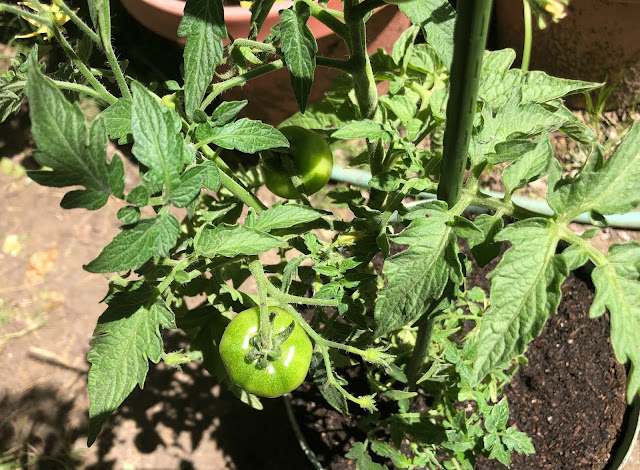
Surviving triple-digit temps comes down to moisture and mulch
 |
|
Container tomatoes, like this Orange Pixie, should be watered frequently during high temperatures. The soil can dry out much quicker than for in-ground tomatoes. (Photo: Kathy Morrison)
|
Tomatoes love heat and sun, but how much is too much?
Prolonged triple-digit heat waves can toast tomatoes and other sun-loving crops. Tomatoes in particular tend to be temperature sensitive.
When temperatures stay above 95 degrees, tomato flowers may drop off or refuse to set fruit. Leaves can fry and turn crispy. Ripening tomatoes may split or develop calluses.
Give your vines a hand – along with enough water and shade – to cope with this week’s heat. This advice comes from UC Cooperative Extension master gardeners as well as longtime local tomato growers.
* Water early and deep. Irrigate your tomatoes in the morning, making sure water reaches down at least 6 inches into the soil. How do you know? Test the soil with a probe or long screwdriver; it should easily plunge into the soil. Or use a trowel, dig down and look.
* During hot weather, water tomatoes two to three times a week. Tomatoes normally wilt during a hot afternoon; that’s OK. But if they’re wilted in the morning, water immediately. (Note: A few heirloom varieties, particularly of Russian origin, have a natural tendency to wilt all the time. But if you are growing one of these, you've probably noticed this already.)
* Tomatoes planted in containers may need extra water every day during hot weather. Their potting soil tends to dry out faster.
* Keep watering consistent and don’t let soil dry out completely. That can lead to blossom end rot, the hard brown callus on the flower end of a tomato.
* Mulch is your friend. Make sure your vines have at least 2 to 4 inches around them to help keep roots cool and soil evenly moist. Straw, leaves or shredded bark make the best tomato mulch. Many gardeners prefer straw (not hay) because its light color reflects intense sun rays instead of absorbing that added heat. (Also, hay contains seeds that can sprout and suck nutrients out of soil.)
* Don’t fertilize during a hot spell. Feeding now just puts more stress on the plant.
* Tomatoes love sun, but they can get sunburned. If leaves or developing fruit look bleached out or burned, give your vine some afternoon shade. Erect a temporary shade structure by draping burlap or shade cloth over the tomato cage or trellis. This also helps prevent fruit from cracking.
* If foliage turns brown, leave the dead leaves in place for now. They help protect the fruit from sunburn. After the heat has subsided, prune off the completely dead leaves so new foliage can grow.
Comments
0 comments have been posted.Sacramento Digs Gardening to your inbox.
Food in My Back Yard Series
April 29: What's (already) wrong with my tomato plants?
April 22: Should you stock up on fertilizer? (Yes!)
April 15: Grow culinary herbs in containers
April 8: When to plant summer vegetables
April 1: Don't be fooled by these garden myths
March 25: Fertilizer tips: How to 'feed' your vegetables for healthy growth
March 18: Time to give vegetable seedlings some more space
March 11: Ways to win the fight against weeds
March 4: Potatoes from the garden
Feb. 25: Plant a fruit tree now -- for later
Feb. 18: How to squeeze more food into less space
Feb. 11: When to plant? Consider staggering your transplants
Feb. 4: Starting in seed starting
Sites We Like
Garden Checklist for week of May 4
Enjoy this spring weather – and get gardening!
* Plant, plant, plant! It’s prime planting season in the Sacramento area. Time to set out those tomato transplants along with peppers and eggplants. Pinch off any flowers on new transplants to make them concentrate on establishing roots instead of setting premature fruit.
* Direct-seed melons, cucumbers, summer squash, corn, radishes, pumpkins and annual herbs such as basil.
* Harvest cabbage, lettuce, peas and green onions.
* In the flower garden, direct-seed sunflowers, cosmos, salvia, zinnias, marigolds, celosia and asters. (You also can transplant seedlings for many of the same flowers.)
* Plant dahlia tubers. Other perennials to set out include verbena, coreopsis, coneflower and astilbe.
* Transplant petunias, marigolds and perennial flowers such as astilbe, columbine, coneflowers, coreopsis, dahlias, rudbeckia and verbena.
* Keep an eye out for slugs, snails, earwigs and aphids that want to dine on tender new growth.
* Feed summer bloomers with a balanced fertilizer.
* For continued bloom, cut off spent flowers on roses as well as other flowering plants.
* Add mulch to the garden to maintain moisture. Mulch also cuts down on weeds. But don’t let it mound around the stems or trunks of trees or shrubs. Leave about a 6-inch to 1-foot circle to avoid crown rot or other problems.